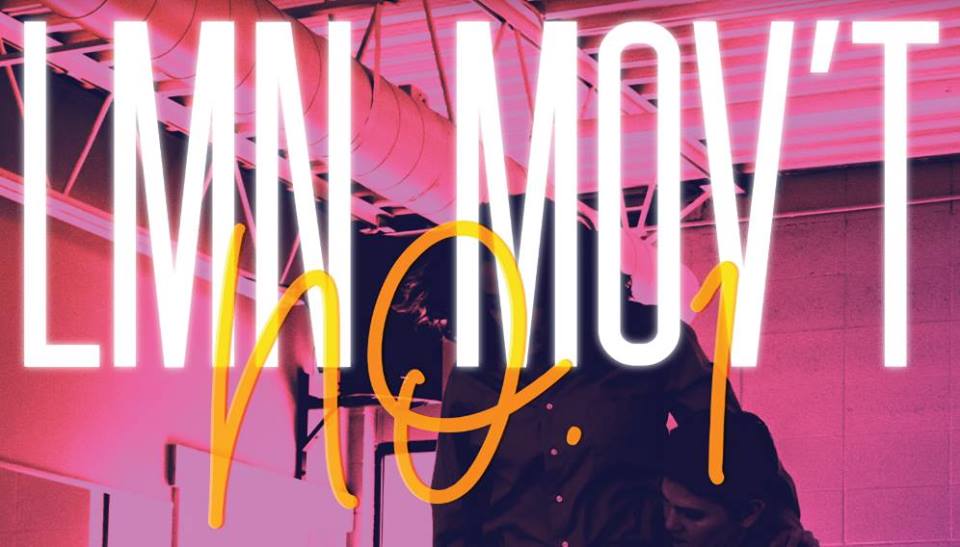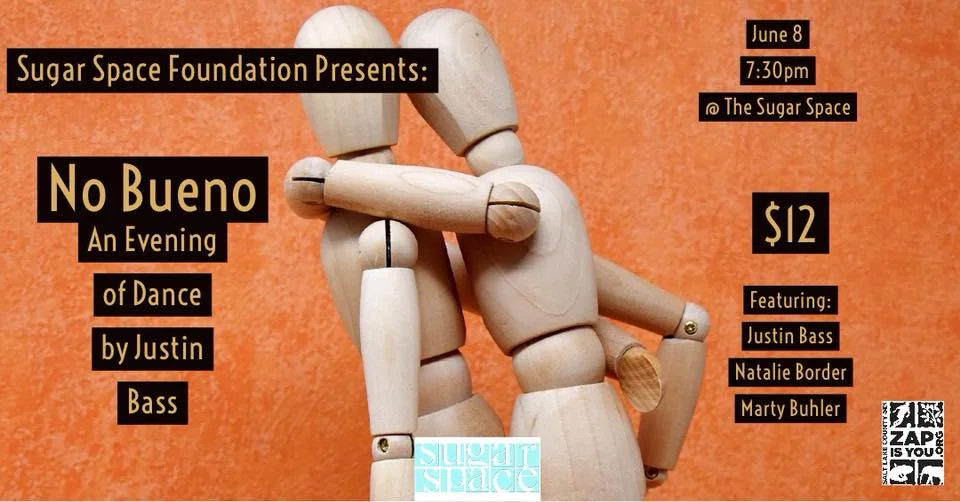Long associated with DIY art-making and performance, warehouse venues demand a conscious balance between activating cost-accessible spaces and making them both functional and inviting to viewers. LMN Mov’t No. 1, a collaboration between Meagan Bertelsen, Natalie Gotter, and Peter Larsen, fully realized the production potential of Sugar Space Arts Warehouse more so than any other performance I have experienced there. The thoughtful staging under the technical direction of Larsen framed compelling works from artistically mature creators and performers. The white flooring contrasted with the dark drapes to delineate the stage and beautifully captured the shadows cast from diffuse lighting (otherwise often unequal to the space). Barn-door framing later shaped this same soft light into hard lines that effectively limned stage sections.
LMN Mov’t No. 1 was an hour-and-a-half-long work comprised of four pieces, fronted with the admirably concise artists’ statement, “The works seen tonight invoke the role of the individual and their surroundings, examining how we interact, work, and create with the world and other people around us.” After viewing the show, I interpreted the statement in the following way: “Experienced people making the art they want to make, with the people they want to make it with, in the way they want to make it.” This was, I think, a very successful composition from artists who are not defensive about their work’s intention and value, who collaborate willingly and meaningfully. It was certainly an exploration of human action/interaction within the scope of the intersection of subject and environment - but it largely did not demand that you acknowledge it as such. The theoretical underpinnings were less visible than the experience of dance, which I took to be a great sign of maturity and aesthetic confidence. I was personally struck with the notion that a solo can be a remarkable encapsulation of collaboration, and to a greater degree than ensemble pieces.
The opening solo, “Hunter,” illustrated this beautifully: the stage was set with a lovely tableau - two chairs, one holding a lush houseplant and the other a box fan, with several can lights loose on the floor. Bertelsen first activated the fan, and later played its grid like a harp (after the recorded notes of Alice Coltrane’s harp were several minutes past, a wonderfully subtle evocation); she adeptly inverted a long buttoned coat and turned on the lights, trailing them along the path of their floorwork, and, memorably, affectingly embraced the fronds of the houseplant, all of which made Bertelsen an immediate and sustained active agent in the space. Bertelsen’s performance seemed to simultaneously inhabit and connect on several layers of abstraction - the venue, the stage, and their body - with an ease informed by years of thesis research in solo improvisation. Under the direction of Brianna Lopez, “Hunter” fluidly passed through discrete ideas, each with a radically different movement quality and intensity. This was accurately and succinctly reflected in the program notes, invoking “the evolving role of subject and its surroundings” and “constant shifts of attention...through the explored body states and interactive environment,” a description which was met and exceeded.
The accompanying notes for “Carry From Below” were less illuminating. A quote by famous NFL coach Vince Lombardi was gender-inverted to evoke ideal woman as triumphant samaritan-warrior. It was presented without author attestation of Lombardi or otherwise, so I assumed the substitution to be choreographer Natalie Gotter’s. The conceit was very interesting - an act of reaction and also creation, claiming something in a way that thoroughly unseats it. However, there was little evidence of this notion in the work itself. I was inclined upon viewing to examine some aesthetic biases I personally hold - namely, the feminine-but-pragmatic ensemble conventions of hair half-back-half-down and similar pedestrian clothing (here, flowy florals) with black sportswear, accompanied by overtly lyrical singer-songwriter music. I realized I dislike these conventions not because they are traditionally feminine (which is wonderful as a deliberate choice) or not-quite homogenizing (which uniform costuming can achieve and individuated costuming can belie), or overly emotive. Rather, because they are so familiar as to provide a blank slate that the work then is responsible to fill, which “Carry From Below” never quite achieved. Partner contact appeared under-motivated, without the physical weight or gestural context to lend it gravity. The lyricism of Nico’s “I’ve Been out Walking,” paired with on-the-nose walking-path choreography, borrowed emotional content from the external musical modality without embodying its own.
The pure movement created by Gotter and the dancers, and their performance of it, was truly strong and graceful; notably, a solo moment by Christine Glidden and a duet by Xochitl Marquez and Ashley Creek, each of which I wished would have lasted longer. I did, however, appreciate being given cause to examine my biases and have concluded that at their root, my dislike of these conventional forms rests on how much harder this nullity of stagecraft makes it to appreciate the hard work and interesting product. I wished the identity theory cleverly used to such effect in the notes had been used visibly in the performed work - otherwise, I am not, as an audience member, able to credit its presence.
During the brief intermission, it felt as though the lobby might break into a contact improv jam. The local dance community was out in force to support LMN Mov’t even at a matinee, testament to the contributions of its creators to this scene. The second half began with a request to hold all applause to the end, as there would be transitions - an injunction that was perhaps unnecessary. For one, because it is always destined to go unheeded, but also because the slightly contrived visual continuity of lighting was superfluous. The works shown were all capable of standing alone, cohesive because of the strength of their refined craft and artistry.
Choreographer/performer Emma Sargent began “Firmament” in an upstage corner, and immediately held every gaze with a series of progressively intensifying leg swings, her grounded torso static and shadowed. Thus obscured by her own legs, Sargent subtly stroked the floor with her toes, an image later mirrored with her fingers in a standing inversion, and in the final supine gesture of sweeping circling hands. These variations of levels and distal articulation were thematic touchstones in an utterly captivating performance. In contrast to the opening solo work, “Firmament” was fierce but also spare and contained, even insulated, which created a gratifying sense of observing, of beholding. Side light was brought in and out, which created shadows that contributed to the sense of communion and dialogue with the space. The quote included in the program was deftly chosen, speaking to natural universal enfranchisement in personal isolation from the artist Björk, and which, in consideration of the well-chosen music of Sigur Rós and Jónsi & Alex, bespoke a certain Scandinavian brand of lonely and lovely.
“Fractals” began with directed light illuminating alternatingly one far lateral third of the stage and then the other. Bertelsen and Larsen each occupied one segment, in well-chosen, completely matching minimalist attire that flattered their strong builds, and the two executed powerful phrases in silence as they were lit in turn. The lights came up, they met on center, and began a partnership of inversions, rolls, and lifts, laborious over-the-shoulder carries accomplished by each in bursts of energy. Gotter’s staging choices and movement creation/direction were extremely effective here. You were given no choice but to appreciate two driving forces whose encounters were continuous, dynamic power shifts without any internally acknowledged power disparity. It worked, and wonderfully, leaving the viewer to confront any expectations to the contrary and their internalized source. The dancers exited the stage only to be reproduced as projections on the wall in Gotter’s screendance iteration of the work.
“Fractals” was a very well-made piece, but I generally question whether a screendance paired with live performance is incorporated meaningfully, whether it literally or figuratively reframes the work in an additive manner, and if it does or does not undermine the live component. The video piece shown in ‘Part One’ of “Fractals” touched briefly on the continuation of a single movement from one dancer to another, and the accelerated reiteration of movements, like the oft-repeated handstand, which are attainable only through editing. These were prominent enough to enrich the texture of the evocative screendance alone, but not enough to appreciably speak to their conjunction with the live work.
‘Part Two’ of “Fractals” finished the show with a duet between Gotter and Bertelsen. They took their places with heavy footfalls in athleisure neutrals and knee pads, as though to promise floorwork and weight-sharing and good times ahead. They absolutely delivered, establishing an intensity borne out until the end. Bertelsen’s movement was controlled even at difficult speeds and phrases, her energy continuing beyond the line of the limbs, and with a steady gaze. Gotter’s initiated movement from the center, which then exploded outward, even in a posture as ostensibly staunch and static as a held développé to the side, with a gaze consistently fierce and challenging. Watching these very distinct but complementary artists embody moments of unison and contact was endlessly appealing - with endless appeal being a preferred way to finish a show.
I viewed an in-progress presentation of “Fractals” at the last Mudson at the Marmalade Library; I was intrigued then, and am very gratified to have had the opportunity to see how the work has evolved and grown. Indeed, seeing these local artists utilize local platforms to produce works of such full realization is an inspiring look into what is happening in the Salt Lake dance community. Much of the best dance I have seen recently has occurred at two branches of the public library system. The consummate accomplishment of this LMN Mov’t collaboration reminds me that the dedicated work of public servants and independent artists is creating and maintaining the infrastructure of this community in an incredibly heartening way.
Nora Price is a Milwaukee native living and working in Salt Lake City. She can be seen performing with Municipal Ballet Co. and with Durian Durian, an art band that combines post-punk music and contemporary dance.






